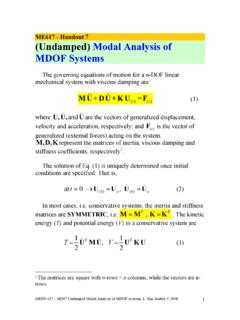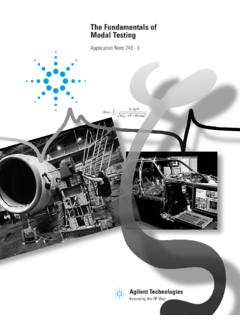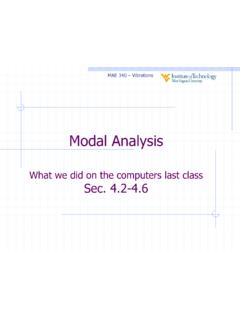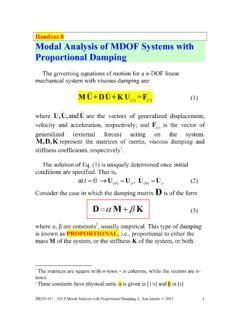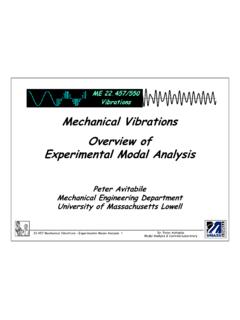Transcription of VIBRATION TESTING Good vibrations - Data Physics
1 30 AEROSPACE TESTING INTERNATIONALMAY 2003 VIBRATION TESTINGGood vibrationsibration TESTING of aircraft is notsomething one may wish toundertake in the air. As well asthe risk and discomfort, it is anexpensive practice. However there is analternative: ground VIBRATION TESTING (GVT). This means of TESTING identifiesmodes of VIBRATION of the aircraft structureby one of two techniques. One techniqueinvolves the aircraft being excited bymulti-input broadband VIBRATION whilethe frequency response functions (FRFs)are measured by the multi-input multi-output (MIMO) method, and multidegreeof freedom (MDOF) curve fitting is usedto identify the modal frequencies anddamping followed by the mode other technique uses multi-inputsinusoidal VIBRATION , forcing a singlemode of VIBRATION to be sustained at atime, with measurements from all loca-tions used directly to compute the modeshapes.
2 A single degree of freedom(SDOF) fit identifies the damping for eachmode. This method, usually referred to asnormal mode analysis (NMA) is not themethod normally used for modal structures that can be excited bya single shaker or an impact device aretested using the broadband MDOF modalanalysis method. NMA was the onlymethod of mode identification until theadvent of the FFT, which gave rise to theevolution of the broadband test techniqueand the consequent development ofMDOF curve fitting. The development ofthe MIMO method, an efficient computa-tional method for evaluating multipleFRFs from simultaneous multiple excita-tions made sure that modes of large andcomplex structures such as aircraft couldalso be characterized using the newlyevolved method of modal TESTING MAY 2003 AEROSPACE TESTING INTERNATIONALThe broadband method is efficient,allowing large-scale tests involving 200 to1,000 measurement locations to be com-pleted in a reasonable length of there is a premium on the avail-ability of aircraft for TESTING during thequalification period, this ability to con-duct large-scale modal tests in a relativelyshort time has been a strong enoughadvantage to tip the choice of the testtechnique in favor of broadband.
3 Sincethe excitation is a low level of VIBRATION ,this method is entirely dependent on lin-earity for the accurate prediction of themodal the increasing use of compositematerials and the greater complexity ofaircraft structures (especially in militaryaircraft) it is becoming apparent that theassumption of linearity cannot be justi-fied. At operational VIBRATION levels theFRFs differ from those observed at lowexcitation levels, making it difficult to pre-dict the modal consideration has revived interestin the sinusoidal technique. The devel-opment of new display indicators andautomation techniques has reduced thetime taken to tune each mode using anumber of shakers. The combination ofthese two factors has cemented the resur-gence of the NMA method for the groundvibration TESTING of aircraft. The expecta-tion that the response at any location ona structure subjected to sinusoidal excita-tion is also sinusoidal is based on linear-ity.
4 A non-linear structure will exhibitnon-sinusoidal response, but when astructure is excited by a sinusoidal forceclose to a natural frequency, the responseis dominated by the mode, which allowsthe mode to be isolated. By appropriateforcing of the structure at multiple loca-VV31 Advanced data acquisition and signal analysis packages can enable effective ground VIBRATION TESTING Sri Welaratna33 VIBRATION TESTING MAY 2003 AEROSPACE TESTING INTERNATIONALthe exact natural frequency. Accuratedetermination of modal frequency isimportant because it heavily influencesthe estimation of damping coefficients,aided by the mode indicator function thatreaches a value close to at natural fre-quencies. The force applied through eachshaker is tuned to the appropriate levelusing the phase indicator which is close as the relative forces balance themotion of the aircraft in a pure mode ofvibration.
5 The forces are all either in phaseor 180 out of phase, depending on thelocation of the order to ensure that the requiredamplitude and phase of force is generatedat each shaker it is advantageous to use aclosed-loop control technique, ensuringthat the force measured at the shaker con-forms to the required level and a mode of VIBRATION is sustained bythe appropriate forces from the multipleshakers, accelerations at all responselocations are measured simultaneously,allowing useful displays such as Lissajouplots and animated mode Lissajous displays in Figure 1 helpto further indicate the force appropriationbecause the display approaches a straightline when the motion is pure. One slider is provided for each shaker and adjuststhe relative force (and phase) applied bythat driver. A Global slider sets the level ofabsolute force by varying all drives whilemaintaining their relative strengths.
6 Theexact shaker frequency may be adjustedwith resolution. Two global indi-cators aide the iterative tuning: the PhaseIndicator (PI) approaches zero while theModal Indicator Function approachesunity as shape-tuning is Figure 2 an animated mode-shapedisplay made during appropriation tuningillustrates the character of the mode andthe quality of its isolation and isolated modes are free of the galloping nodes frequently encounteredin global excitation tests. Appropriatesymmetry and continuity may be verifiedat a glance. This physical separation ofmodes contrasts dramatically with themathematical separation from the broad-band excitation non-linearity is a major concern,changing the force level by scaling all theexcitations allows the mode to be excitedat levels of motion consistent with theoperating conditions. In fact, by making aseries of measurements at varying globalforce levels it is possible to characterizethe non-linear modal behavior.
7 System linearity with force is investi-gated on a mode-by-mode basis (Figure 3).tions the modal response can be rein-forced, ensuring that the residualresponses at other frequencies are toosmall in comparison to affect the accuracyof modal measurements. NMA is alsoknown as force appropriated modal test-ing (FAMT), reflecting the nature of themethod of NMA technique starts with a sinesweep test across the entire frequencybandwidth, enabling rough identificationof all modes. Since it is possible that ashaker may be located close to a node,preventing the excitation of one or moremodes, the sine sweep test is carried outwith more than one modes, especially torsionalmodes, may not be excited by a singleshaker operation so it is important to varythe number and locations of shakers andthe phases of the input to some shakers,and then observe the emergence of addi-tional modes.
8 The first phase identifies thenumber of modes and the approximatenatural Photograph A an aircraft is excitedby eight shakers with 896 responseaccelerometers spread over the entirestructure. The test was performed atEADS in Italy using a Data Physics normalmode test system. Photograph B overleafshows a GVT at NASA Dryden FlightResearch Center where the upper wingsurface of the aircraft is covered withaccelerometers and other sensors. An elec-tro-mechanical shaker device (blue cylin-der at lower right) generates vibrationsinto the airframe during the tests, whichhelp engineers determine if controls andmulti-Lissajous displayused while tuning mode displays help in theobservation of a puremode of NormalMode TESTING is typically applied tolarge and suppleaerospace structuressuch as this completeairframe being testedby EADS in Italy. 12 Acally induced vibrations are controlled orsuppressed during flight.
9 The tests werethe last major ground tests prior to the ini-tiation of research the second phase each mode ischaracterized by individual excitationwith the frequency of excitation tuned toTHE FORCES ARE EITHER IN PHASE OR 180 OUT OF PHASE, DEPENDINGON THE LOCATION OF THE SHAKERS34 AEROSPACE TESTING INTERNATIONALMAY 2003 The global forcing level is stepped acrossa desired range and the frequency isadjusted to optimize tuning at each results in a plot of natural frequency-versus-force level as shown in the lower-left addition to the damping coefficient,other useful calculations are generalizedmass and stiffness at each mode. Thesecalculations are made using the complexpower (CP) and quadrature force (QF)methods. The CP function is derived byadding the real and imaginary componentsof the product of force multiplied byvelocity at all shaker locations. By varyingthe frequency of excitation over a smallrange across the natural frequency the realor active part of CP reaches a maximum atthe natural frequency and the imaginaryor reactive part crosses zero at the naturalfrequency (Figure 4).
10 An SDOF curve fitof the complex power spectrum yields themass, stiffness and damping the QF method, a small compo-nent of force, proportional in amplitudebut quadrature in phase is added to eachshaker, resulting in a slightly detunedresponse. The straight-line slope of fre-quency vs quadrature coefficient is thenused to derive the generalized mass. Thedisplay features greatly reduce the time totune each mode the Anderson methodallows the force appropriation to be dri-ven automatically, further reducing timeand effort. It is sometimes debatable if thenormal mode method is of longer dura-tion than the broadband method thisbecomes more noticeable in measurementsituations where there is a poor signal-to-noise ratio and a large number of averagesare necessary to measure the broadbandfrequency response function. Anotheradvantage of the sinusoidal test is thephysical aspect.


